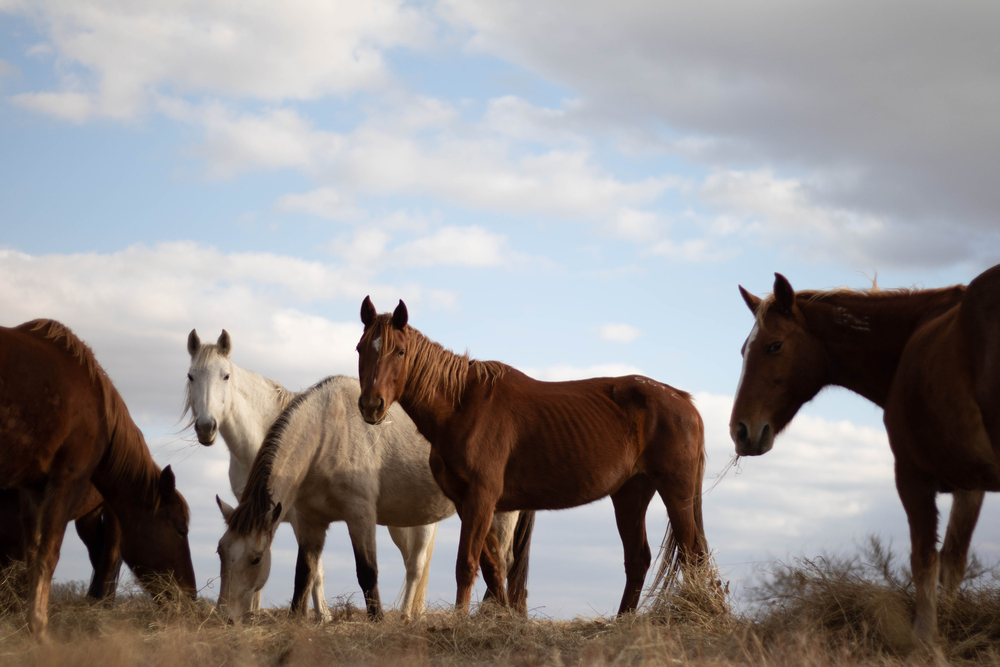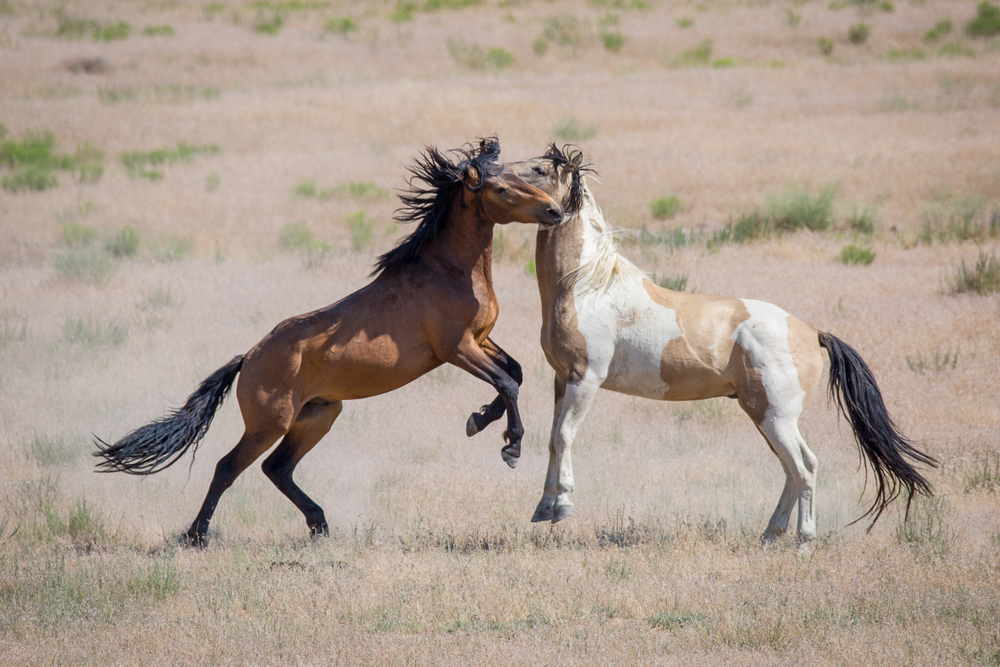- Your source for stall mats, rubber arena footing, arena harrows and arena dust control.

Many newcomers feel bewildered and lost as experienced horse people throw around terms like “mustang,” “bronco,” “broncing,” and “bronc riding.” Knowing the difference between these terms is key to following and participating in conversations surrounding feral, wild, unbacked, or problematic horses.
Broncos are wild or semi-trained horses, whereas mustangs are feral descendants of Spanish horses living in the U.S. Bronco refers to a horse’s level of training. Mustangs are a specific American horse population. A mustang may start life as a bronco, but with training will not stay a bronco.
If you have ever stabled your horse at a busy yard, you may have heard an instructor muttering about a “crazy bronco.” Expecting them to be referring to the resident mustang, you feel your confusion mounting when you realize they are talking about the well-bred Hanoverian youngster currently doing handstands in the arena. Which is the bronco, the half-backed youngster or the mustang?
What Is The Difference Between A Mustang And A Bronco?
Despite many people believing that broncos and mustangs are the same, this is not true.
Bronco is a Spanish word meaning rough. The Mexican vaqueros used the word “bronco” to describe untrained or half-trained horses. Eventually, the use of the term bronco spread across the border, and American cowboys began using the word “bronco” to describe wild horses brought in for backing.
The Merriam-Webster Dictionary formally defines broncos as unbroken or imperfectly broken range (feral or wild) horses of Western North America.
When the 16th century Spanish Conquistadors invaded America, some of their trained riding horses escaped. These horses began to breed and populate the formerly horseless country.
The Spanish Conquistadors referred to these horses as “mostrenco” and “mestengo,” meaning masterless cattle. Eventually, the term evolved into the modern word “mustang.”
According to the Merriam-Webster Dictionary, a mustang is a small, hardy, naturalized horse descended from Spanish horses and found on the U.S. western plains.
To summarize the difference between a bronco and a mustang:
A bronco refers to a horse’s level of training, while a mustang is a specific horse population found in America.
What Is The Link Between Mustangs, Broncos, And Bronc Riding?
While mustangs and broncos are not the same things, there remains an undeniable link between the two concepts.
In the 1800s, Cattle Barons and landowners would allow large herds of untamed horses to roam their lands. Many of these feral horses were true mustangs, i.e., naturalized descendants of the Spanish horses.
Once a year, cowboys would round up and separate the riding age horses from the herd; the captured horses were kept as future riding horses.
These newly captured horses were mistrustful of humans and fought the process that would turn them into docile riding horses. Riding a bronco became synonymous with riding a bucking horse.
Cowboys began placing bets on who could stay on a bucking bronco the longest. Eventually, this led to the formalization of the sport, and the first record of an advertised bronc riding event was in 1882, hosted by Buffalo Bill’s Wild West Show.

Why Were Mustangs Known As Bucking Broncos?
Horses will buck for one of three reasons:
- To protect themselves from predators that try to attack them.
- To rebalance themselves.
- As an expression of excitement and exuberance.
The training methods used during the 18th and 19th century were focused on efficiently producing the required end product, i.e., an obedient, safe cattle horse. Quickly getting through the training process was more important for a working cowboy than the horse’s comfort.
Because the cowboys used “rough-and-ready” methods to break horses in, almost all the mustangs that the 18th and 19th cowboys worked with epitomized a bucking bronco.
These feral mustangs reacted to the riders as if they were predators; the mustangs’ bucking was fierce and unrelenting as they genuinely believed they were fighting for their lives.
As horsemanship evolved, horsemen and women moved towards a more compassionate way of working with horses based on horse ethology.
Modern horsemanship emphasizes the development of a horse’s trust and confidence using a systematic approach to training. Under the guidance of a skilled horse trainer, a mustang’s first rides should be focused on relaxation and building the horse’s confidence.
Some horses can and do buck even if the trainer has done everything right. However, horsemen and women should not assume that bucking in a newly backed mustang is an unavoidable automatic response to a rider.
Are Mustangs Good For Bronc Riding In Rodeos?
Bronc riding has become one of the feature events in Rodeos across America. There are two types of bronc riding, saddle riding and bareback riding.
Saddle broncs are larger horses with a classic rhythm and style to their bucking, whereas bareback broncs are smaller, more athletic horses. A good bareback bronc is capable of athletic bucking with rapid changes in direction and bucking style.
A mustang is generally too small to be a good saddle bronc, but a few exceptions exist. A feral mustang is a compact, surefooted horse capable of throwing wicked bucks. However, just because a mustang can buck doesn’t mean they have the temperament to be a good rodeo bronc.
The best rodeo broncs often feature some combinations of quarter horse, thoroughbred, and draft bloodlines. The draft influence provides the power, while the quarter horse and thoroughbred provide the athleticism required in a rodeo bronc.
Are Mustang Trainers The Same As Bronco Trainers?
A mustang trainer working with feral mustangs is also a bronco trainer when the term “bronco” describes a rough, wild or semi-trained horse. A mustang trainer working with backed, well-trained mustangs is no longer a bronco trainer as the mustang can no longer be called a bronco.
However, the term bronco is no longer used exclusively for untrained horses; it is more commonly used to refer to the bucking broncos used in rodeos.
A modern bronco trainer trains rodeo broncos, not riding horses. Bronco trainers actively encourage a horse to buck, while a mustang trainer works to gentle mustangs and teaches them not to bronc. A mustang trainer is not the same as a bronco trainer when used in this context.
Conclusion
Mustangs can be broncos, and broncos can be mustangs, but the two terms are not synonymous.
A mustang is a horse hailing from a specific horse population, i.e., the feral descendants of Spanish horses currently roaming the plains of Western U.S.A. By contrast, bronco was the traditional term used to describe an unbacked or newly backed horse.
A mustang will always be a mustang regardless of its training level; the same cannot be said of a bronco. As the mustang’s training advances, the term bronco will no longer apply to the mustang.
References
- https://www.smithsonianmag.com/science-nature/14-fun-facts-about-broncos-180949553/

- https://www.livescience.com/50714-horse-facts.html

- https://www.merriam-webster.com/dictionary/mustang

- http://www.naiaonline.org/articles/article/professional-rodeo-horses-are-bred-to-buck#sthash.wvrHaa8q.dpbs

- https://westernhorseman.com/rodeo/bucking-horse-breeders-association-adds-integrity-and-incentives-for-stock-contractors-and-rodeo-producers/


